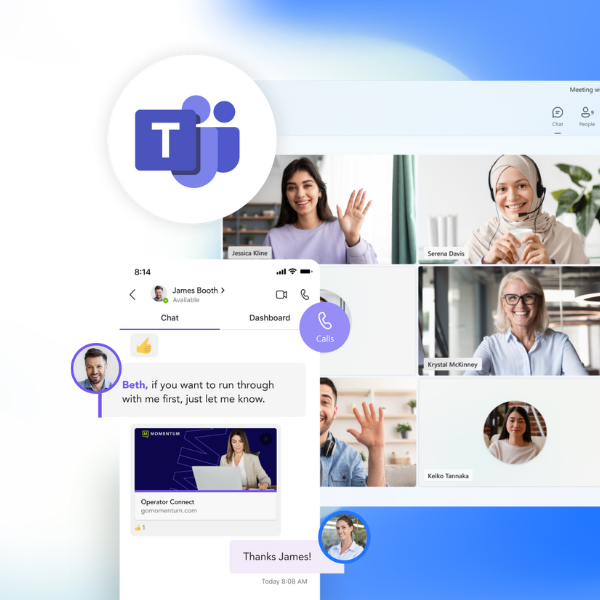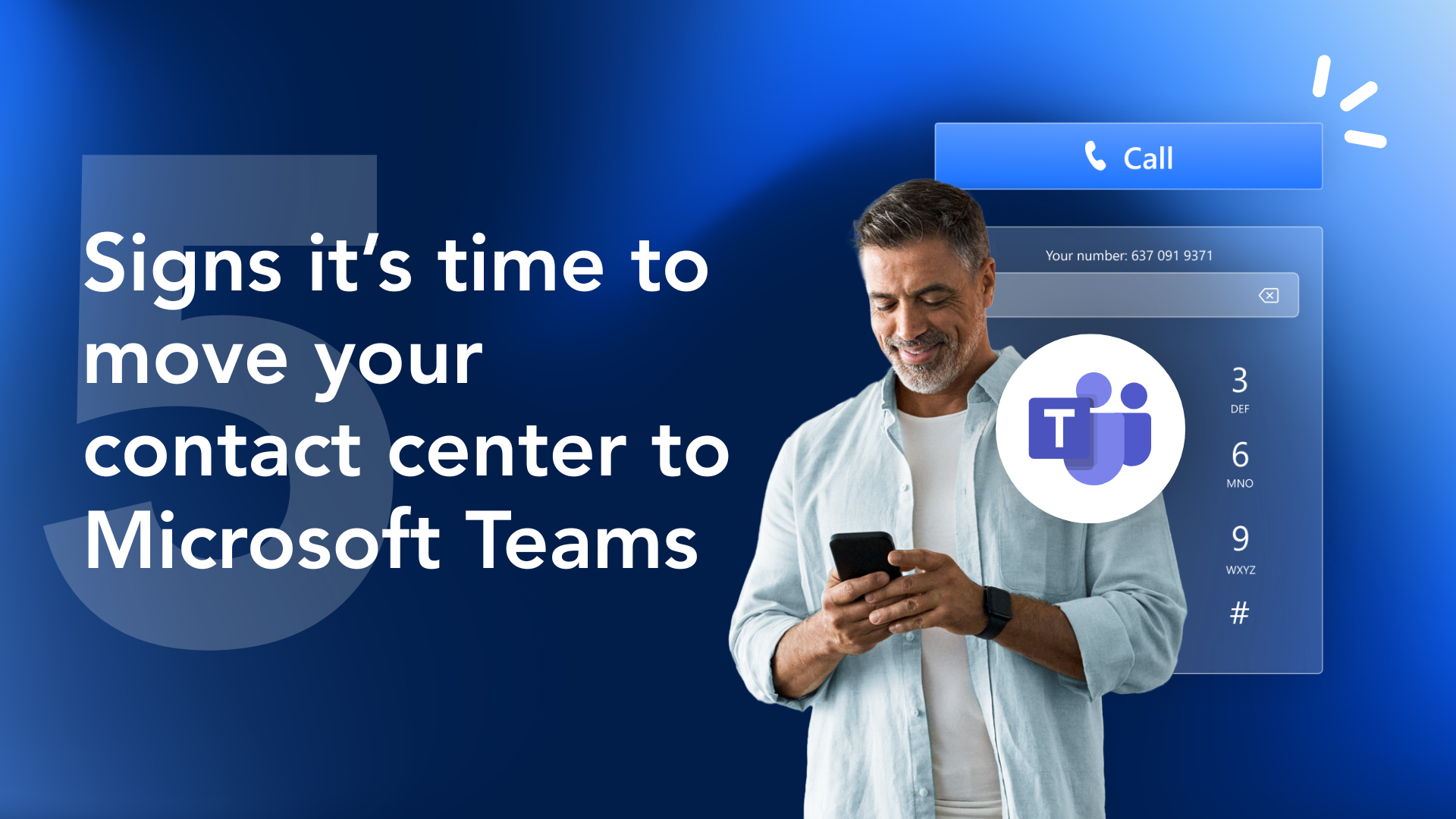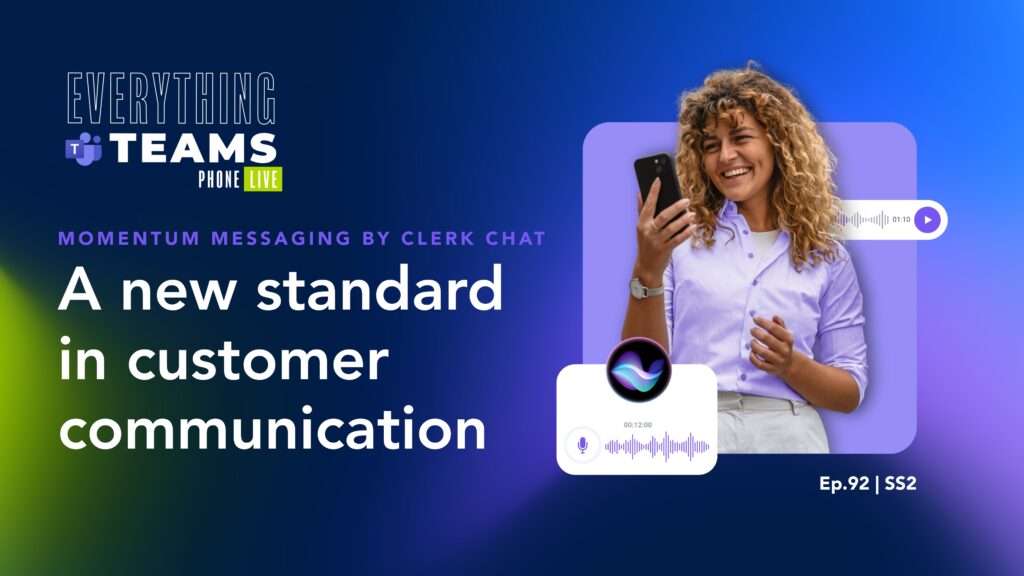Your agents are already in Microsoft Teams to collaborate. But when they have to leave that environment just to help customers, it creates friction. They’re forced to juggle siloed tools, one for calls, another for chat, and yet another for email. It slows them down, increases errors, and wears them out.
The result? Slower response times, missed insights, and frustrated customers. But that’s not all. Constant app switching impacts agent job satisfaction, increases burnout, and erodes knowledge retention. It becomes harder to onboard new hires, and harder still to keep the ones you’ve trained.
For businesses racing to cut costs, boost utilization, and offer seamless omnichannel support, staying locked into legacy platforms is a liability. A Teams-native contact center lets you modernize without the usual headaches, no patching, hardware refresh cycles, and vendor juggling. You get an evergreen, SaaS-based infrastructure that evolves with you.
Because if your agents are ready, your platform should be too. Here are five signs your contact center is ready to make the move.
1. Your agents are already using Microsoft Teams
Your agents already live in Microsoft Teams. It’s where they chat, meet, and collaborate. So why make them leave that familiar space just to serve customers?
Forcing agents to switch between apps creates friction that slows them down and wears them out. Integrating your contact center into Teams simplifies everything. It gives agents a single, unified workspace that combines your agent desktop with internal business communication in one app.
Organizations that adopt unified communications platforms like Teams see a 52% boost in team productivity on average. When your agents can work where they’re already comfortable, they respond faster, collaborate more easily, and deliver better outcomes.

Key benefits:
- Unified interface: Agents manage all calls, chats, and meetings inside Microsoft Teams.
- Less app switching: Reduce friction and boost focus with fewer tools in play.
- Faster internal help: Agents can loop in subject-matter experts instantly through Teams.
- Simpler onboarding: New hires get up to speed quickly with fewer systems to learn. Because Teams is so well-adapted across businesses, most agents will already be familiar with it.
2. Supporting remote or hybrid work is a challenge
Traditional contact center platforms weren’t built for distributed teams. Many require VPNs, custom configurations, or physical hardware to function remotely. These limitations create friction that slows down service and frustrates both agents and customers.
Microsoft Teams, combined with Luware Nimbus, gives you a cloud-first contact center designed for anywhere access. Your agents get full functionality from home, the office, or on the go, with no trade-offs in performance, visibility, or security.
Security isn’t an afterthought either. With built-in compliance controls, encrypted communications, and access management aligned to Microsoft 365, your agents can work remotely without compromising sensitive data or customer trust.
Cloud-based contact centers also drive efficiency. Businesses using these platforms see a 27% reduction in costs and handle customer inquiries 35% faster than those using on-premises systems.
Key benefits:
Cloud-based access: Agents work securely from any location with an internet connection.
Device flexibility: Full functionality on desktops, laptops, tablets, and smartphones.
Consistent experience: No learning curve or tool mismatch across remote and in-office setups.
Enterprise-grade security: End-to-end encryption, role-based access, and Microsoft-compliant controls protect every interaction while still enabling integrations with WhatsApp, SMS, social, webchat, webRTC, AI, and other popular solutions that legacy CXs can’t support.
3. Limited visibility into Contact Center performance
You can’t fix what you can’t see. When performance data is trapped across disconnected systems, supervisors are left guessing. Wait times rise, service levels slip, and training gaps go unnoticed. Without real-time visibility, every decision becomes reactive instead of strategic.
Momentum’s Teams-native contact center, powered by Luware Nimbus, brings performance insights directly into the platform your team already uses. Supervisors and managers get immediate access to agent activity, queue status, and customer interactions with no extra dashboards or lag time.
More importantly, AI-powered analytics help you go beyond surface-level metrics. Identify patterns in call volume, flag recurring service issues, and surface coaching opportunities based on live agent performance. With sentiment analysis and historical reporting, you can understand not just what happened, but why, and what to do next.
Companies that invest in connected, intelligent tools like these see up to 25% gains in productivity from better team alignment and faster decision-making.
Key benefits:
- Real-time dashboards: Monitor queue health, agent availability, and live interactions inside Teams.
- Historical reporting: Spot trends, uncover training needs, and plan staffing with the ability to create your own reports using Power BI.
- CRM Integration: Surface key customer data without toggling between systems.
4. Managing multiple vendors and tools is complex
Every tool you bolt on to your contact center adds friction. You’re juggling different platforms for voice, reporting, chat, CRM lookups, and call routing. Each one has its own interface, billing cycle, support process, and upgrade schedule.
That complexity drains IT resources and slows down your ability to adapt to customer needs.
Here’s how:
- For agents, it means more logins, screen switching, and room for error.
- For supervisors, it means fractured data and no clear view of what’s really happening in real time.
- For leadership, it means higher costs with less accountability.
Imagine an agent handling a customer call in one system, checking historical interactions in another, and messaging a teammate in yet another app just to resolve a simple issue. Now multiply that by hundreds of interactions per day. That’s how small inefficiencies turn into massive productivity drains.
Momentum eliminates the sprawl. By consolidating voice, contact center, messaging, and global connectivity into Microsoft Teams, you give your team a single pane of glass to work from, and your business one vendor to rely on.
The financial upside is clear. Companies that move to cloud-based systems see up to a 58% reduction in hardware costs, along with simplified operations and stronger alignment across teams.
Key benefits:
- Single provider: One partner for voice, messaging, contact center, and connectivity.
- Unified billing and support: Fewer contracts, fewer logins, faster resolutions.
- Reduced complexity: Less to manage, maintain, and troubleshoot.
- Consistent experience: Apply the same policies and standards across every interaction channel.
5. Preparing for future growth and innovation
Legacy contact center systems weren’t built to evolve quickly. Scaling often means expensive hardware upgrades, vendor lock-in, or rip-and-replace projects that disrupt service and delay progress. These outdated models make it harder to respond to changing customer expectations and business needs.
A Teams-integrated contact center gives you the agility to grow without the heavy lift. With Luware Nimbus layered into Microsoft Teams, you can scale capacity, add new channels, and adopt AI-powered features without overhauling your infrastructure.
That flexibility isn’t just convenient, either. It’s strategic. Whether you’re looking to implement virtual agents, expand into chat and SMS, or route interactions based on customer history and sentiment, you already have the platform in place.
Companies using omnichannel strategies report a 23x increase in customer satisfaction, and those with strong engagement strategies retain 89% of their customers, compared to just 33% for those without.
Key benefits:
- Scalability: Increase capacity or add channels without major IT investments.
- AI and automation ready: Deploy intelligent routing, virtual agents, and workflow triggers at your own pace.
- Omnichannel support: Engage customers through voice, chat, email, and more from a unified platform.
- Future-Proofed: Stay current with Microsoft and Luware innovations as they roll out.
Why choose Momentum + Luware?
If your organization already relies on Microsoft Teams, your contact center doesn’t need to sit on the sidelines. Momentum and Luware bring it into the center of your business where it belongs.
Together, we deliver a fully embedded, enterprise-grade contact center experience inside Teams. There’s no swivel-chairing or bolt-on tools. You get one seamless platform for internal collaboration and external customer service.
You get the best of both worlds: Momentum’s secure, global voice infrastructure and Luware’s powerful, Teams-native contact center features. It’s a solution built for scale, designed for hybrid work, and optimized for ongoing innovation.
What you can expect:
- Native Microsoft Teams integration: Agents stay productive without leaving their core workspace.
- Omni-channel engagement: Voice, chat, email, and SMS, all managed from a single interface.
- Enterprise-grade security and compliance: SOC 2 Type II, ISO 27001, and GDPR aligned.
- Fast, expert deployment: Launch quickly with minimal disruption.
- Ongoing optimization: Dedicated support and continuous updates to keep you ahead of customer expectations.
How Luware Nimbus works
Luware Nimbus brings advanced contact center functionality directly into Microsoft Teams, turning a collaboration platform into a complete service hub. There’s no clunky middleware or external dashboards, just native features built for frontline efficiency and supervisor control.
Agents handle calls, chats, and emails within Teams. Supervisors configure workflows and monitor performance from the same interface. IT teams don’t need to build or maintain custom integrations. Everything works where your people already are.
Core capabilities:
- Intelligent routing: Automatically direct calls to the right agent based on skill, availability, or customer history.
- Drag-and-drop workflow builder: Design and adjust call flows without code or development time.
- Real-time dashboards: Track queue status, agent performance, and service levels live inside Teams.
- CRM and Microsoft 365 integration: Give agents instant access to customer records and context without toggling tools.
- Omnichannel management: Handle voice, chat, email, and other channels from a single, unified workspace.
Luware Nimbus brings the control, visibility, and flexibility of a modern contact center into the environment your team already trusts: Microsoft Teams.
Industries that benefit & key use cases
While organizations across all sectors can benefit, certain industries particularly thrive when integrating contact centers into Microsoft Teams:
| Healthcare & medical Secure and compliant patient communication, intelligent call routing to clinics or departments, streamlined scheduling workflows, and seamless handoffs between care teams. | Financial services Real-time client support with call recording and audit trails, fraud and risk escalation workflows, compliant communications across voice and chat, and CRM-integrated account servicing. | Professional services Centralized communication hubs for client accounts, streamlined updates and approvals via Teams, improved coordination across remote teams, and time-saving integration with project management tools. | Retail & e-commerce High-volume order and return handling, dynamic routing during peak seasons, personalized support via integrated purchase history, and faster agent onboarding across distributed locations. |
|---|---|---|---|
| Technology &
SaaS 24/7 global support desks with intelligent escalation, real-time incident response, unified communication between product and support teams, and integration with platforms like Salesforce or Zendesk. | Government & public sector Citizen service centers with intelligent queueing, multilingual support built into workflows, secure remote staffing, and real-time reporting to track service performance and transparency metrics. | Education (K-12 & post-secondary) Automated routing for admissions and registrar inquiries, real-time student services across departments, virtual advising sessions, and consistent experiences across phone, chat, and email. | Manufacturing & logistics Order and delivery status updates, plant-to-warehouse coordination, vendor communication tracking, and intelligent call flows to reduce missed handoffs and downtime. |
Healthcare & medical
Secure and compliant patient communication, intelligent call routing to clinics or departments, streamlined scheduling workflows, and seamless handoffs between care teams.
Financial services
Real-time client support with call recording and audit trails, fraud and risk escalation workflows, compliant communications across voice and chat, and CRM-integrated account servicing.
Professional services
Centralized communication hubs for client accounts, streamlined updates and approvals via Teams, improved coordination across remote teams, and time-saving integration with project management tools.
Retail & e-commerce
High-volume order and return handling, dynamic routing during peak seasons, personalized support via integrated purchase history, and faster agent onboarding across distributed locations.
Technology & SaaS
24/7 global support desks with intelligent escalation, real-time incident response, unified communication between product and support teams, and integration with platforms like Salesforce or Zendesk.
Government & public sector
Citizen service centers with intelligent queueing, multilingual support built into workflows, secure remote staffing, and real-time reporting to track service performance and transparency metrics.
Education (K-12 & post-secondary)
Automated routing for admissions and registrar inquiries, real-time student services across departments, virtual advising sessions, and consistent experiences across phone, chat, and email.
Manufacturing & logistics
Order and delivery status updates, plant-to-warehouse coordination, vendor communication tracking, and intelligent call flows to reduce missed handoffs and downtime.
Your agents are ready. Is your platform?
The signs are clear. If your agents are already in Microsoft Teams, there’s no reason to keep customer interactions siloed in outdated systems. Momentum and Luware give you the power to unify collaboration and customer service in one seamless environment.
You’ll simplify operations, reduce costs, and unlock real-time insights that elevate both agent performance and customer satisfaction.
Stop patching together platforms and start building a contact center that moves with your business.



